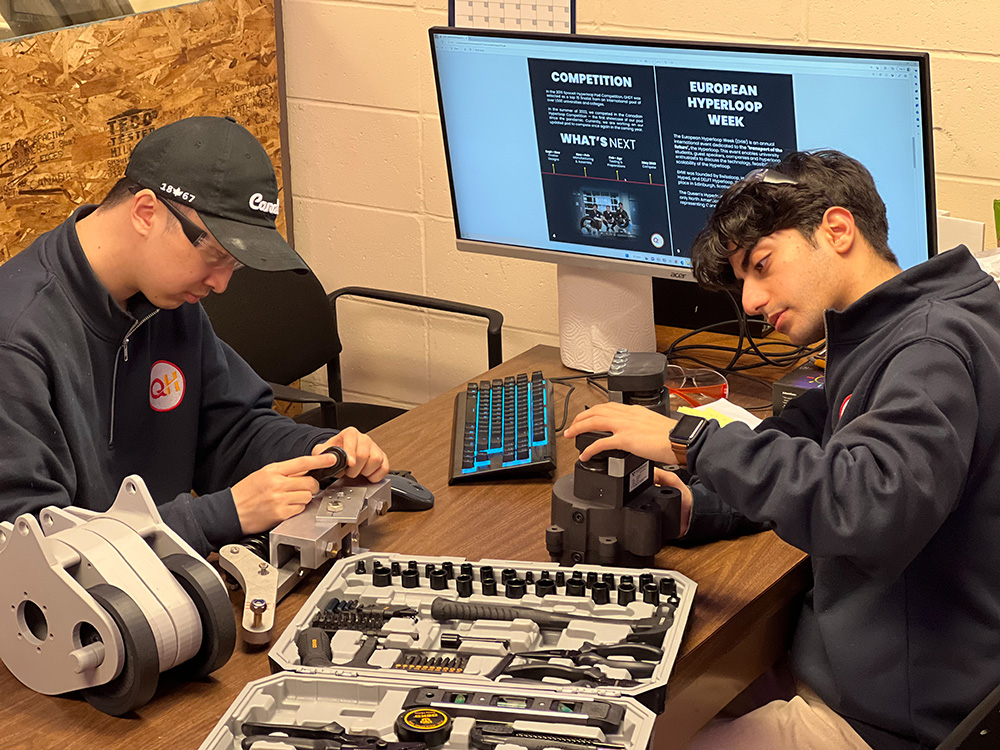The Queen’s Hyperloop Design Team is one among thousands of groups from around the world answering the call since 2015 to help make the “fifth mode of transport” a reality. They all have slightly different ideas of what that could look like, but all of them involve high-speed pods zipping people and products through low-pressure tubes. Some of those teams, including Queen’s Hyperloop Design Team (QHDT), test their prototypes against each other at competitions in Canada and internationally every year.
Saman Saeidi, a third-year Computer Engineering student, is co-captain of QHDT. He says that as futuristic as hyperloop might sound, the idea of a new form of travel can no longer be science fiction. We need it now. “We’ve seen how crazy airports are getting, how slow trains are, how inefficient it is to get from one point to another,” he says. “Hyperloop is a solution for that, and that’s why I’m passionate about it, and why I think a lot of other students are, too.”
Here at Queen’s, those passionate students aren’t just from the Faculty of Engineering and Applied Science. The 150 members of QHDT include representation the Faculties of Arts and Science, Education, and the Smith School of Business. They are split into three sections:
Since 2019, the team has been redesigning QHDT’s very first pod — the one that was famously chosen to compete at Space X’s now-defunct Hyperloop Pod Competition. “It’s a really exciting time, because this year is actually when we’re going to finish our redesign,” says co-captain and third-year Mathematics and Engineering student Kevin Liang. “So, to wrap up, we just have to finish manufacturing our parts and assembling them, and then test the pod.”

Then it’s time for competition. First up is the Canadian Hyperloop Conference in Waterloo in the spring. Then, at European Hyperloop Week in Edinburgh this summer, QHDT will be among just a handful of Canadian teams in attendance. The team is also putting together a special group with the Robert M. Buchan Department of Mining to compete in the Not-a-Boring Competition in the U.S. in 2024 or 2025. The Canadian Hyperloop Conference has also expressed interest in hosting the 2024 or 2025 competition in Kingston in partnership with QHDT and Queen’s University. The team’s R&D subsystem has started preliminary planning on a proposed test track to be built in Kingston ahead of a potential CHC competition.
Yet as important as competition is to QHDT, it’s not all about beating rivals. As with any student design team at Queen’s, this is good career preparation, say Liang and Saeidi. Both captains aim for careers in product development, and both agree that they have picked up skills that will come in handy after graduation.
For Saeidi, one of the big ones is communication. “You have to communicate very efficiently and effectively both externally with all these teams and competitions in Canada and around the world, but also internally,” he says. “We have all of these different people from different disciplines working together, so finding ways to communicate with all of them and making sure we’re all on the same page is really important.”
For Liang, problem-solving is one of the major skills he has honed with QHDT. “The problems here aren’t easily defined,” he says. “Sure, it could be one like designing a piece for the pod, but it’s also solving problems between team members and solving problems with your work, like inefficiencies in your project management execution. You don’t learn those types of things unless you are part of a design team.”
Design teams like QHDT are a lot bigger than any one person. “They’re a portal to the industry,” says Liang.

Kevin Liang and Saman Saeidi are co-captains of Queen’s Hyperloop design team